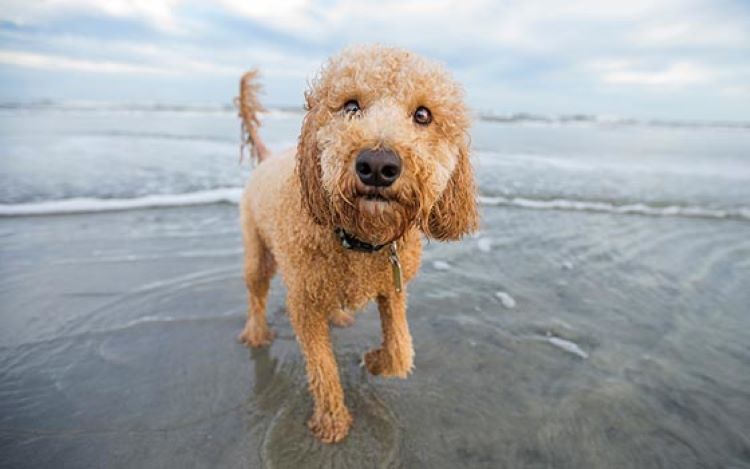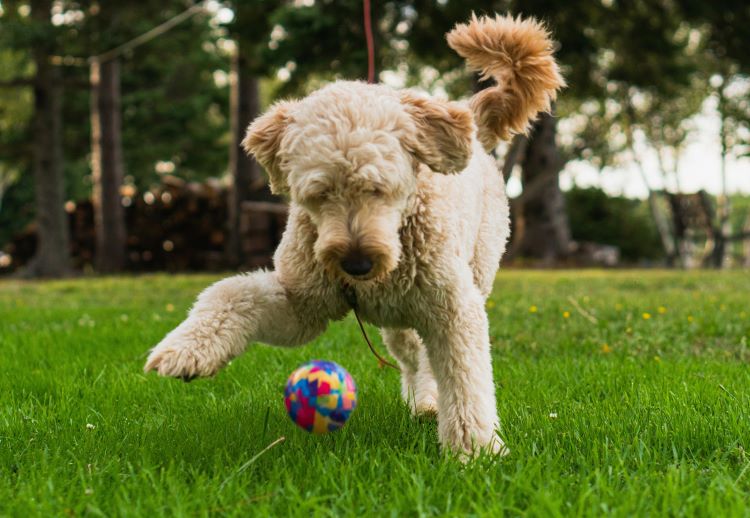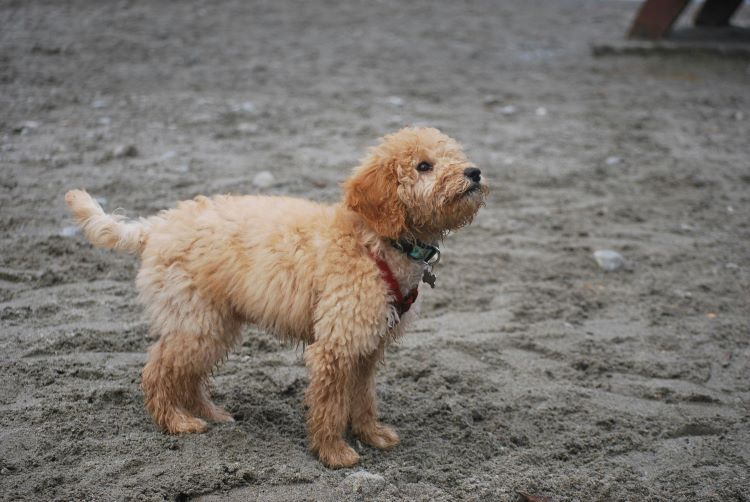Ready to help treat your pet to a healthy life?
A Guide to the Goldendoodle
By : Trupanion Staff | Updated Mar 20, 2024

Ah, the charming and energetic Goldendoodle. Also referred to as a doodle (along with other dog breeds of similar genetic origins), this pup soared in popularity during the 1990s and early 2000s after its introduction to family homes (scroll down for more on the breed's history). With allergy-friendly coats and delightful demeanors, Goldendoodles are particularly sought-after in North America and Australia. They've even served as guide dogs, agility competitors, and therapy dogs, as well as search-and-rescue animals! But what exactly is this dog breed, and how did it grow to prominence?
Whether you're considering adopting a doodle of your own or are just curious about these fascinating canines, this Goldendoodle guide is here to help.
What exactly is a Goldendoodle?
A Goldendoodle is considered a designer dog breed. It's an intentional hybrid, a cross between a Poodle and a Golden Retriever. These doodles often exhibit the intelligence of the Poodle, paired with the friendliness and ease of training Golden Retrievers are known for. Because both parent breeds are sporting and water dogs, Goldendoodles are energetic and love having a job to do — especially if that job is being an outstanding family companion.
Since Poodles come in various size ranges, so does the Goldendoodle. They fall into three different categories as a result:
- Petite / Toy: under 25 pounds
- Miniature: 25 to 45 pounds
- Standard: 45 to 100 pounds
As of 2024, Goldendoodles are not a recognized dog breed by the American Kennel Club.
Similar dog breeds
Considering a pal like the Goldendoodle? These dogs share some close physical traits, not to mention many similarities in terms of temperament:
- Golden Retriever
- Standard Poodle
- Labradoodle
- Lagotto Romagnolo
- Portuguese Water Dog
9 Fun facts about Goldendoodles
- Known as Goldendoodles in the United States, this breed is called “Groodle” in Australia.
- Goldendoodles are popular choices for therapy or service dogs.
- They have webbed feet, making them great swimmers!
- Goldendoodles come in lots of colors! Many are a golden color due to their Golden Retriever genes, but they can also be cream, brown, black, red, silver, or brindle, and even have splashes of different colors (usually on their chest).
- Though kennel clubs don’t recognize them as a purebred dog, Goldendoodles can still register with these clubs to participate in agility or obedience events.
- The Goldendoodle’s coat can be styled in a variety of ways, from an all-over, same length “kennel cut” to fancier Poodle-style cuts and even Lion cuts — you might even see doodles sporting mohawks!
- While poodles and their crosses are often more hypoallergenic and therefore better for people who are allergic to dogs, it’s not always the case. Every dog, every person, and every situation can be different.
- Goldendoodles generally live for between 12 and 15 years, though their lifespan can be influenced by their size and other genetics.
- There are several different types of Goldendoodle classifications, based on their ancestry and according characteristics.
Are Goldendoodles hypoallergenic?
Thanks to its Poodle genetics, the Goldendoodle has a low-shed coat with a curly or wavy appearance. But despite being marketed as a hypoallergenic dog breed as a result, the truth is a bit more complex. Every doodle inherits traits from both of its direct ancestors, meaning that they can vary greatly in terms of how much dander they produce as well as how much they actually shed. As a result, many Goldendoodles can be considered hypoallergenic, but many others cannot.
Genetics and allergy-friendly coats
Breeders now classify Goldendoodles with the terms F1, F1B, F2, and Multigen, which tells you what breed or breed mix the puppy's parents are. Often this is done to highlight specific characteristics of one of the originating breeds, such as the curlier Poodle coat.
- F1 — Golden Retriever + Poodle (First Generation)
- F1B — Poodle + F1 Goldendoodle (Second Generation)
- F1BB — F1B Goldendoodle + Poodle (sometimes Golden Retriever) (Third Generation)
- F2 — F1 Goldendoodle + F1 Goldendoodle (Third Generation)
- F2B — F2 Goldendoodle + Poodle (sometimes Golden Retriever) (Third Generation)
- F2BB — F2B Goldendoodle + Poodle (sometimes Golden Retriever) (Fourth Generation)
- Multigen (F3): Goldendoodle + Goldendoodle (F1B, Multigen) or Poodle
If you or a family member has allergies, it's a good idea to meet potential dog friends first before deciding to adopt one. If possible, find out their genetics from the breeder. The most “allergy-friendly” Goldendoodle tends to be an F1B coat, meaning a Goldendoodle is backcrossed with a purebred Poodle, making them ¾ Poodle and ¼ Golden Retriever.

Breed history
Goldendoodles became popular in the 1990s in the United States and Australia (where they are called ‘Groodles’), bred with the family-friendly temperament of a Golden Retriever and the allergy-friendly coat of a Poodle. Encouraged by the development of the Labradoodle in 1989, Goldendoodles were also bred to be hypoallergenic therapy and service dogs, but quickly became sought after as family pets due to their friendly nature, intelligence, loyalty, and obedience skills. Given this mix, it’s no surprise the Golden Retriever consistently ranks in the top 5 most popular dog breeds in both the United States and Australia.
In the beginning, Goldendoodles were only available as what is called the F1 Standard, meaning puppies were bred from a Standard Poodle and a Golden Retriever parent. As people became more familiar with the breed, breeders received requests for a smaller version of Goldendoodle and began crossing the Golden Retriever with the smaller Miniature Poodle, creating the Mini Goldendoodle.
Behavior and training
Goldendoodles have a great combination of the Golden Retriever’s social nature and the Poodle’s intellect. Their playfulness and ease of training make for a breed that thrives in a variety of dog jobs and sports. Start training young to keep their minds engaged, build foundational skills and positive socialization experiences, and prevent bad habits from developing. Doodles love to constantly learn new things, so consider daily trick training once you’ve got the basics down.
How do Goldendoodles do with others?
- While doodles are known as a very social and friendly breed, positive, proactive exposure to new sights, sounds, people, dogs, and other animals as a young puppy is essential for their socialization skills.
- Their outgoing personalities and love of being near their human family make them a regular choice for families with children. Take care to introduce and socialize them with children as a young puppy to set them up for success and create a positive association. Young children and dogs should always be supervised, and it’s helpful for a dog to have their own “safe space” where they can go when they need some quiet time.
- Goldendoodles can enjoy the companionship of other animals in the home, as long as they have been properly socialized and introduced.
Exercise requirements
A Goldendoodle’s size determines the amount of daily exercise needed, and this breed will benefit from different types of physical activity beyond a daily walk. Goldendoodles usually love to swim, thanks to their water dog parents. Just be sure to thoroughly dry and brush out their coat to prevent matting and hot spots after swimming or getting wet.
Once a Goldendoodle is fully grown, they can make excellent jogging or hiking partners, but also love to take a long, meandering walk where they can sniff to their heart’s content.
Speak with your veterinarian about appropriate exercise for a Goldendoodle puppy. Until they are full-grown (bone growth plates typically all close by around 12 to 18 months of age), avoid strenuous or repetitive activities like jogging or running, as this can possibly increase their risk of damage to the growing bone and cartilage and cause pain and future joint issues.
Mental enrichment
The Goldendoodle breed benefits greatly from daily mental stimulation and brain games to keep them happy and entertained. Participating in positive reinforcement training for obedience or teaching tricks is a fantastic way to burn extra energy and further build the canine-human bond.
Common behavioral issues
Due to their love of companionship and their sociability, Goldendoodles need positive exposure to alone time from puppyhood to help prevent or minimize any separation anxiety from developing. It’s much easier to prevent than to treat once it’s started. Make alone time a positive and relaxing experience for your Goldendoodle.
Ideal activities for Goldendoodles
Goldendoodles enjoy a variety of dog sports, jobs and other activities:
- Dock Diving
- Therapy Work
- Service Animal Training
- Search and Rescue
- Agility
- Rally-Obedience
- Canine Freestyle
- Flyball

Grooming and care
Goldendoodles come with a variety of coat types, depending on what genes they receive from each parent. Their coat can be slightly wavy (closer to their Golden Retriever side) or more curly or wiry (closer to the Poodle coat).
Often Goldendoodles are said to require minimal grooming, but this is entirely dependent on each individual’s coat. In most cases, the Goldendoodle coat needs daily brushing to prevent matting and regular professional grooming to keep the length manageable. If left ungroomed, the coat can grow up to 8 inches long. The hybrid coat is prone to matting and can quickly become a painful problem if the mats develop close to the dog’s skin: the curlier the coat, the more likely to mat.
Set yourself and your Goldendoodle up for success by introducing them to the brushing and grooming process as a puppy and in a positive way, with regularly-scheduled professional grooming at least every 8 to 12 weeks (or more frequently if you prefer a shorter coat length).
A Goldendoodle puppy as young as 12 weeks can be introduced to professional grooming, whether at a grooming salon or scheduling a mobile groomer to come to your home. You’ll want to make sure the facility is clean, your puppy is kept separate from other dogs, and they are up-to-date on vaccinations and parasite preventatives (be sure to check with your vet first). Breeders can introduce their puppies to different grooming tools (such as brushes, nail trimmers, and clippers) and handle them in a positive way as young as 5 weeks old. Owners can continue this proactive exposure training when they bring the puppy home.
Goldendoodles in pop culture
Despite being a relatively new breed, the Goldendoodle has been frequently spotted in the homes of well-known individuals. Expect to see the Goldendoodle popping up in TV and other media in the coming years.
Famous owners of the Goldendoodle
- Usher Raymond (Singer, Actor)
- Barbara Eden (Actress)
- Ashley Tisdale (Actress)
- Tiger Woods (Golfer)
- Dustin Brown (Hockey player)
- Hillary Scott (Musician)
- Kenny Chesney (Musician)
- Perez Hilton (Blogger, TV personality)
- John Travolta (Actor)
- Anže Kopitar (Hockey player)
Famous Goldendoodle
Lulu the Funeral Home therapy dog made headlines in the 2010s due to her work comforting mourners in a funeral home.
